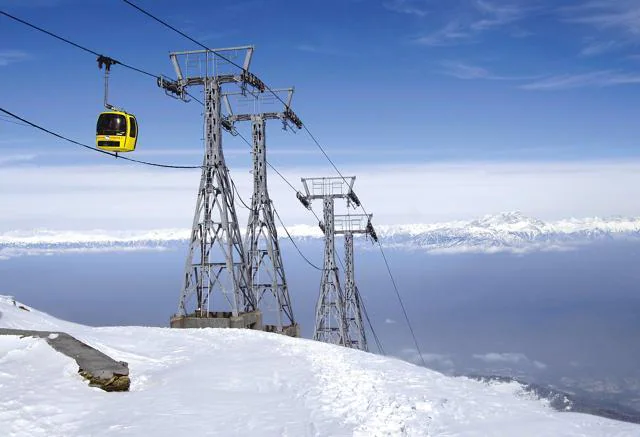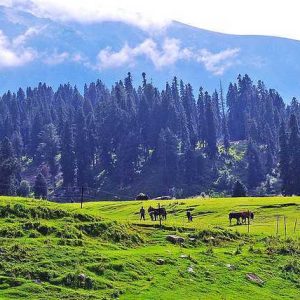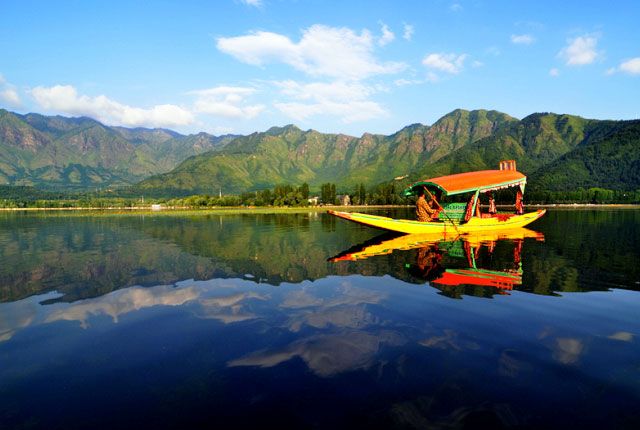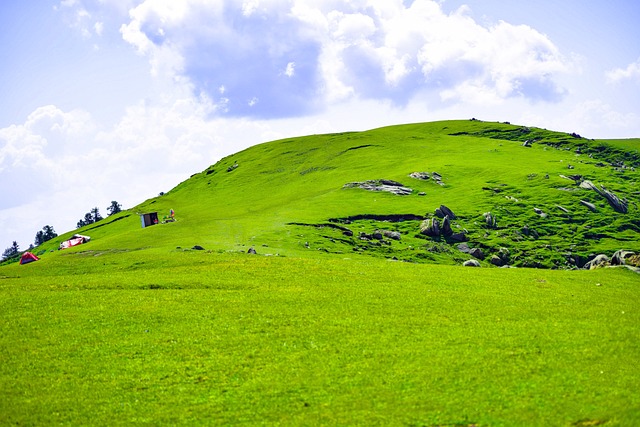
Gulmarg Gondola Stages
Table of Contents
ToggleOverview
Nestled between the towering Himalayas in the middle of Kashmir is one of the world’s highest and most stunning cable car experiences: the Gulmarg Gondola. Acclaimed as a marvel of modern mountain engineering, the Gulmarg Gondola platforms treat thrill seekers, skiers, photogs, and nature lovers to a ride across snow-covered mountains and verdant valleys. In this comprehensive guide, we’re going to cover each and every point you’d like to know about visiting Gulmarg and taking the Gondola ride.





Why Visit Gulmarg?
Gulmarg, another name for the “Meadow of Flowers,” is a tourist destination throughout the year. From pristine winter snowfall that makes it the classic Gulmarg ski resort, to flowers that bloom in summer and cover the slopes with a garden of flowers, this destination has something for every kind of traveler. The Gulmarg Gondola itself is a destination and gateway to the region’s most daring activities, including heli-skiing, snowboarding, and even easy treks to the nearby Apharwat Peak. Whether you’re searching for “Gulmarg tourism highlights” or planning a “Gulmarg sightseeing itinerary,” the Gondola stages are the must-do experience that tops every visitor’s list.
Overview of Gulmarg Gondola Stages
The Gulmarg Gondola is divided into two main sections, or stages, each ascending to breathtaking altitudes:
- Stage 1: From Gulmarg Resort to Kongdoori Station
- Stage 2: From Kongdoori Station to Apharwat Peak Station
Both stages combined see the Gulmarg cable car ascend from around 2,650 meters to 4,000 meters above sea level. This two-stage journey is unequalled in South Asia and one of the continent’s highest and longest cable car experiences. Gazing out as you ascend, be on the lookout for chestra trees, glacial valleys, and maybe even the elusive Himalayan pheasant.
Stage 1: The Gateway to Alpine Bliss
Departure Point & Boarding
Your Gulmarg Gondola adventure begins at the bottom station of the Gulmarg resort, conveniently proximate to town guesthouses and hotels. Boarding is efficiently organized, and employees guide you into spacious, glass-enclosed cabins meant for breathtaking views. During peak season—winter especially—please arrive early to avoid hours of wait as “Gulmarg snow activities” draw swarms of enthusiasts.
Scenic Highlights
- Pahalgam Range: On a clear day, one can view the snow-covered Pahalgam peaks in the northeast.
- Coniferous Forests: Close fir and pine forests clothe the hillside below, preying to the vibrantly hued wildflowers in summertime.
- Meadow Views: Stage 1 ride offers eye-catching vistas of Gulmarg’s famous meadows, painted with multicolored flowers in July and August on the slopes, and transforming “Gulmarg summer tourism” into a heaven for photographers.
Duration & Altitude Gain
Stage 1 is approximately 2.5 kilometers in 8–10 minutes, from an altitude of 2,650 meters to 3,200 meters. The ascent is gentle enough for newbies to high-altitude treks, but the mountain atmosphere, so foreign to the normal air pressure, is sometimes beyond newcomers’ expectations. Consume water, inhale slowly, and take in the scenery spread out before you.
Kongdoori Station Facilities
There are restrooms, a tea stall and snack shop selling hot tea and local fare, and souvenir shops selling Kashmiri shawls and handicrafts at Kongdoori station. It is a good spot to acclimatize before embarking on Stage 2, especially if you’re planning on high-altitude snowboarding or photography at Apharwat.
Stage 2: Apharwat Peak Ascent
The Ultimate Elevation Challenge
Stage 2 is when the cable car at Gulmarg becomes legend stuff. It climbs from 3,200 meters to around 4,000 meters, traversing over one of the steepest slopes on any cable car system in the world. The ride lasts about 12–15 minutes, but every single ride is filled with stop-your-heart scenery.
Panoramic Spectacles
- Apharwat Glacier: A wide, white sheet seen through the windows of the cabin, perfect for “Gulmarg glacier trekking” enthusiasts.
- Himalayan Crest: On very clear days, you would be able to spot Nanga Parbat’s distant summit slashing across the sky.
- Snow-Capped Ridgelines: The high ridges remain snowy even during summer, offering throughout-the-year “Gulmarg snow experience.”
Weather & Precautions
The weather is unpredictable at nearly 4,000 meters. Temperatures are often below freezing, even in late spring. Always wear waterproof and insulated clothing, sturdy boots, sunglasses or goggles, and sunblock. Acute mountain sickness (AMS) can cause mild symptoms due to altitude; if you feel dizzy or queasy, descend to Kongdoori station and rest.
Apharwat Peak Station Amenities
While the facilities at Apharwat are minimal—mostly a small shelter and basic first-aid—you’re here for the unparalleled vistas and adventure, not luxury. Many visitors use this point as the launchpad for:
- Heli-Skiing: Bookable through local operators, this extreme sport ranks among the best “Gulmarg heli-skiing adventures.”
- Snowboarding & Skiing: Gentle slopes near the station are perfect for beginners, while steeper runs beckon expert skiers.
- Photography Excursions: Capture the shifting shadows on the glacier and the gentle dance of clouds on mountain ridges.
Ticketing & Pricing Details
A bit of planning is essential in order to enjoy hassle-free Gondola rides. Here’s the lowdown:
- Combined Two-Stage Ticket: Covering both Stage 1 and Stage 2. Ideal for tourists who intend to travel up to Apharwat Peak.
- Single-Stage Ticket (Stage 1 only): Excellent if you want to climb the first ascent and descent only.
- Children & Senior Citizens: Concession rates; always carry valid ID.
- Opening Times: Usually 9:00 AM to 5:00 PM, but tending to vary in times of heavy snow.
- Booking Facilities: Pre-book online booking recommended, especially in January and February when “Gulmarg busiest season” is most popular. On-the-day tickets available at ticket counter, as and when available.
Including “Gulmarg Gondola ticket price” in your search will give you the latest tariffs, which alter very little year to year. Be sure to check latest prices on official state tourist websites prior to arrival.
Best Time to Visit for the Gondola Ride
The beauty of Gulmarg differs by season, and your ideal Gondola trip depends on what you desire
- Winter (December–March): Optimum snow period for skiing, snowboarding, and snowy landscape photography shots. Expect sub-zero temperatures and perfectly set snow.
- Spring (April–June): Fresh air, thawing snow, and the first flushes of alpine flowers make it a transition wonderland. Day temperatures are approximately 10–15°C, ideal for trekking.
- Summer (July–September): The meadows are carpeted with wildflowers. While there is still snow on the upper slopes, the lower slopes erupt into riotous color. Perfect for picnics and “Gulmarg summer festivals.”
- Autumn (October–November): Post-monsoon clarity means crystal-clear skies and warm temperatures—a photographer’s dream. But services may be thin as operators prepare for winter.
Chasing “Gulmarg snow activities” or an adventure for a “Gulmarg meadow picnic,” choose your season carefully to fit your adventuring style.
Safety Measures & Guidelines
A trip to high altitudes demands responsibility—personal safety, as well as responsible behavior for the environment.
- Acclimatize Gradually: Start at Stage 1, linger for at least 30 minutes before heading to Apharwat.
- Hydrate & Snack: Carry water and high-energy snacks like nuts and energy bars.
- Dress in Layers: It’s a wild temperature fluctuation; waterproof shell coats and insulating mid-layers are essential.
- Obey Instructions: Listen to cable car operators’ guidelines regarding boarding procedures and before previous announcements.
- Altitude Sensitivity: In the event of repeated headache, dizziness, or shortness of breath, come down immediately and seek medical help at the base clinic.
- Adhere to the Environment: Don’t litter; utilize station-specific receptacles. Participate in local “Gulmarg clean-up drives” to give back to this godly terrain.
Insider Secrets for an Unforgettable Ride
- Sunrise & Sunset Trips: The morning and evening trips offer gentler light and smaller crowds—great photography.
- Cabin Location: Sit on the valley edge side for optimal views.
- Local Guide Rental: Extremely useful if you will be skiing or hiking beyond the station complexes. Local guides can point out hidden glacial lakes and animal trails.
- Couple with Gondola + Trek Package: Most operators package your Gondola trip with a guided trek to Alpather Lake or nearby shepherd huts.
- Altitude HQ Planning: If altitude-sensitive, do your first night in a lower-altitude Kashmir town (like Pahalgam) before arriving in Gulmarg.
- Camera Protection: Cold, as well as rapid altitude change, fogs lenses—keep silica gel packets in your camera bag.
Spell “Gulmarg Gondola tips” when searching to discover even more insider tips from holiday sites and recent blogs.
Neighboring Attractions & Activities
Alpather Lake Trek
One can trek moderately 6–8 km from Kongdoori Station to a remote high-altitude lake, frozen deep into summer. Alpather Lake is a favorite destination for those searching for off-beat “Gulmarg trekking experiences.”
Khilanmarg Meadow
Short trek or drive from Gulmarg town, the flower-covered slopes of Khilanmarg are within easy reach on pony ride or jeep safari. An ideal supplement to your Gondola outing, it offers “Gulmarg wildflower meadows” in plenty.
Strawberry Valley
About 8 km from Gondola base, this valley is carpeted with wild strawberries in June and July—a nice spot for a mid-trek picnic.
Local Culture & Cuisine
Explore Gulmarg’s quaint town center to sip Kashmiri tea (noon chai), saffron-spiced rice dishes such as wazwan, and local breads. The town shops also stock lovely Pashmina shawls and walnut wood carvings—ideal souvenirs.
Environmental & Community Initiatives
It is necessary to preserve the fragile Himalayan ecosystem. The Gulmarg Gondola project works with local forest departments and community groups to:
- Reforest Alpine Slopes: Willow and juniper saplings native to the area are planted annually.
- Waste Management Drives: Public clean-up drives involving tourists and locals are ongoing.
- Sustainable Energy Trials: Solar-powered cabins and LED lighting for stations reduce carbon footprints.
- Community Training: Young people are given hospitality and safety training so that they can maintain tourism without losing Kashmiri heritage.
By choosing reputable tour operators and following guidelines, tourists help make the stunning “Gulmarg cable car system” an icon of sustainable mountain tourism.
Frequently Asked Questions
Q: What is the difference between Stage 1 and Stage 2 tickets?
A: Stage 1 ticket to Kongdoori Station resort of Gulmarg, ideal for beginners and photographers. Stage 2 ticket (or combined ticket) for the entire ride to Apharwat Peak, ideal for skiing and snow sports.
Q: Are pets allowed on the Gondola?
A: Generally, no, safety and hygiene reasons. Service animals may possibly be with advance permission.
Q: Do I ski back to Gulmarg town?
A: Only veteran skiers attempt this challenging run; it is not recommended without a trained local guide.
Q: How cold is the temperature at Apharwat Peak?
A: It drops as low as –10°C or even lower in winter—dress warmly.
Q: Are there network mobile networks?
A: Networks are sporadic above Kongdoori. Download apps or offline maps before ascending.
Conclusion
The Gulmarg Gondola stages are more than just a cable car ride; they represent the pinnacle of Himalayan adventure. Whether you’re chasing “Gulmarg snowboarding thrills,” planning a “Gulmarg photography tour,” or simply seeking to bask in awe-inspiring vistas, the two-stage journey delivers in every season. From the lush lower meadows to the icy heights of Apharwat Peak, each segment unfolds new perspectives on Kashmir’s natural splendor. By planning carefully—booking tickets in advance, dressing for high-altitude weather, and respecting local conservation efforts—you’ll ensure your Gulmarg Gondola experience is safe, sustainable, and unforgettable. Pack your camera, lace up your boots, and prepare to soar through the clouds: the ultimate Himalayan adventure awaits on the Gulmarg Gondola.
How to book Kashmir tour?
Contact a travel agency that specializes in Kashmir tours. You can reach out to the following for assistance:
- Phone:
- +91 7889 655596
- +91 7006 891267
- Email:
Inquire about tour packages, itineraries, and pricing, and confirm your booking for a memorable winter experience!
People Also Ask
What are the two stages of the Gulmarg Gondola?
Stage 1 runs from Gulmarg Resort (2,650 m) to Kongdoori Station (3,200 m), and Stage 2 continues from Kongdoori up to Apharwat Peak (approximately 4,000 m).
How long is the ride on each stage of the Gondola?
Stage 1 takes about 8–10 minutes; Stage 2 takes around 12–15 minutes, depending on weather and passenger load.
What is the current Gulmarg Gondola ticket price?
Prices vary yearly; expect around ₹1,000–₹1,200 for Stage 1 and an additional ₹1,000–₹1,200 for Stage 2. Concessions often apply for children and seniors.
When is the best time to ride the Gulmarg Gondola?
For skiing and snowboarding, visit December to March. For wildflower meadows and trekking, April to June. Autumn (October to November) offers clear skies and mild weather.
Are advance Gondola bookings required?
In peak winter (January to February) and summer (July to August), advance online booking is strongly recommended to avoid long queues.
What are the operating hours of the Gulmarg Gondola?
Typically 9 AM to 5 PM; timings may adjust during heavy snowfall or maintenance periods.
Is there any age or health restriction for the Gondola ride?
No strict age limit, but very young children, pregnant women, and those with severe respiratory or cardiac conditions should consult a doctor due to high altitude.
Can I experience altitude sickness on the Gondola?
Mild symptoms like headache or nausea can occur above 3,000 m. Acclimatize at Kongdoori Station, hydrate well, and descend if symptoms worsen.
What should I pack for the Gulmarg Gondola ride?
Layered warm clothing, waterproof outerwear, sturdy boots, sunglasses or goggles, sunblock, energy snacks, and a camera with extra batteries.
Is there mobile network coverage on the Gondola?
Coverage is generally available up to Kongdoori Station; above that, signal can be intermittent. Download maps and info offline.
Can I ski or snowboard from Apharwat Peak?
Yes—Apharwat offers beginner to expert slopes. Heli-skiing operators also run from this station for advanced powder runs.
Are pets allowed on the Gulmarg Gondola?
Pets are not permitted, except verified service animals with prior approval by authorities.
Can I trek from the Gondola stations?
Popular treks include the Alpather Lake trek (6–8 km from Kongdoori) and short hikes toward Khilanmarg meadows.
What facilities are available at Kongdoori Station?
Restrooms, a small café serving tea and snacks, souvenir stalls, and seating areas for acclimatization.
What amenities exist at Apharwat Peak Station?
Basic shelter, first aid, and a viewing platform—amenities are minimal, so plan for limited cover.
How crowded does the Gondola get in peak season?
Weekends and holidays see heavy footfall. Arrive at opening time or book online to minimize wait times.
Is photography allowed inside the cabins?
Absolutely—glass-paneled cabins provide 360° views, making them perfect for panoramic mountain photography.
Are food and drinks available on the Gondola?
No onboard service. Purchase refreshments at the base or at Kongdoori Station before ascending further.
Can I return after Stage 1 without doing Stage 2?
Yes—you can buy a single-stage ticket and descend back to Gulmarg Resort from Kongdoori Station.
What’s the difference between combined and single-stage tickets?
A combined ticket covers both stages up to Apharwat Peak; a single-stage ticket is valid only for Stage 1 (Gulmarg to Kongdoori).
Are there restroom facilities on the Gondola?
No restrooms in cabins; use facilities at the base station or Kongdoori Station before ascending Stage 2.
Is the Gulmarg Gondola wheelchair accessible?
The base and Kongdoori stations have limited accessibility; Stage 2 is generally not recommended for wheelchairs.
What is the Gondola’s passenger capacity?
Each cabin holds 4–6 passengers. Approximate throughput is 600 persons per hour per direction.
Does the Gondola operate in heavy snowfall or high winds?
Operations may pause during severe weather for safety. Check real-time updates before planning your ride.
How do I purchase Gulmarg Gondola tickets online?
Visit the Jammu & Kashmir tourism official portal or authorized travel websites, select your date and time slot, pay online, and present the e-ticket at the counter.




